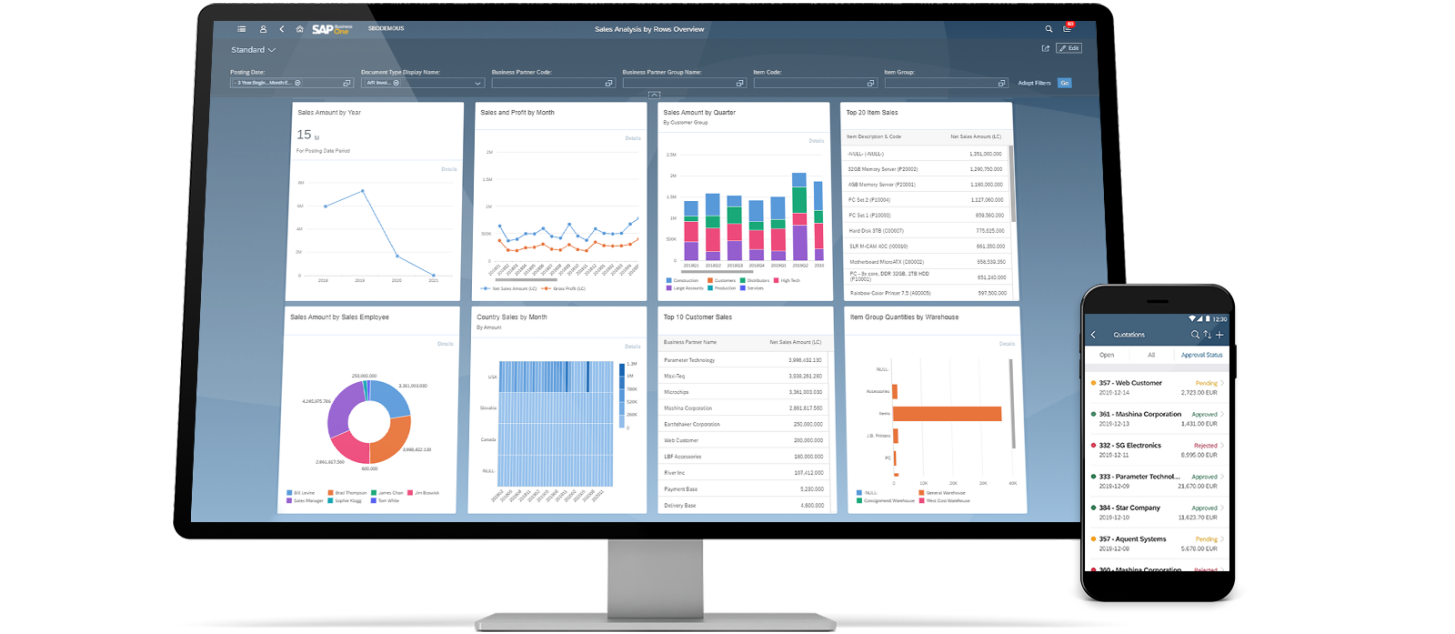In today’s dynamic business landscape, small to medium-sized enterprises (SMEs) face unique challenges. From managing finances and inventory to nurturing customer relationships and optimizing supply chains, the complexities can be overwhelming. This is where SAP Business One steps in, offering a comprehensive and integrated Enterprise Resource Planning (ERP) solution tailored to meet the specific needs of growing businesses.
SAP Business One isn’t just software; it’s a strategic partner designed to streamline operations, enhance efficiency, and ultimately drive profitability. It empowers you to gain a holistic view of your business, make data-driven decisions, and adapt quickly to changing market conditions. Think of it as a central nervous system for your company, connecting all vital functions and providing real-time insights.
This article will delve deep into the world of SAP Business One, exploring its core functionalities, benefits, implementation considerations, and how it can revolutionize the way you manage your business. We’ll cover everything from accounting and finance to CRM and manufacturing, providing a comprehensive understanding of how this powerful solution can unlock your company’s full potential.

Why Choose SAP Business One for Your SME?
The decision to implement an ERP system is a significant one, and choosing the right solution is crucial for long-term success. SAP Business One stands out from the crowd for several compelling reasons:
1. Integrated Functionality: Unlike disparate systems that require manual data entry and prone to errors, SAP Business One offers a fully integrated platform. This means that all your business processes, from sales and marketing to production and finance, are seamlessly connected. This integration eliminates data silos, reduces errors, and provides a single source of truth for all your business information.
2. Scalability and Flexibility: As your business grows, your needs will inevitably evolve. SAP Business One is designed to scale with you, accommodating increasing data volumes, expanding user bases, and new business requirements. The flexible architecture allows you to customize the system to fit your specific processes and add modules as needed, ensuring that your ERP solution remains aligned with your evolving business strategy.
3. Real-Time Visibility: Access to timely and accurate information is essential for informed decision-making. SAP Business One provides real-time visibility into all aspects of your business, allowing you to track key performance indicators (KPIs), identify trends, and respond quickly to opportunities and challenges. With powerful reporting and analytics capabilities, you can gain a deeper understanding of your business performance and make data-driven decisions that drive growth.
4. Improved Efficiency: By automating manual tasks, streamlining workflows, and eliminating redundancies, SAP Business One can significantly improve operational efficiency. This frees up your employees to focus on more strategic activities, such as innovation, customer service, and business development. The result is increased productivity, reduced costs, and improved overall performance.
5. Enhanced Customer Relationships: Customer Relationship Management (CRM) is an integral part of SAP Business One, enabling you to manage customer interactions, track sales opportunities, and provide exceptional customer service. By centralizing customer data and automating sales and marketing processes, you can build stronger relationships with your customers, increase customer loyalty, and drive revenue growth.
6. Comprehensive Reporting and Analytics: SAP Business One comes equipped with a wide range of reporting and analytics tools that provide valuable insights into your business performance. You can generate reports on sales, inventory, financials, and other key areas, allowing you to track progress towards your goals and identify areas for improvement. The system also supports ad-hoc reporting, allowing you to create custom reports to meet your specific needs.
7. Cloud Deployment Options: SAP Business One offers both on-premise and cloud deployment options, giving you the flexibility to choose the deployment model that best suits your needs. Cloud deployment offers several advantages, including lower upfront costs, reduced IT infrastructure requirements, and easier scalability. On-premise deployment provides greater control over your data and infrastructure, which may be important for some businesses.
8. Cost-Effectiveness: While the initial investment in an ERP system may seem significant, SAP Business One offers a strong return on investment (ROI) by streamlining operations, reducing costs, and improving overall efficiency. The system’s modular design allows you to start with the modules you need and add more as your business grows, making it a cost-effective solution for SMEs of all sizes.
9. Strong SAP Ecosystem: SAP is a global leader in ERP software, and SAP Business One benefits from the company’s extensive ecosystem of partners, developers, and resources. This means you have access to a wide range of expertise and support, ensuring a smooth implementation and ongoing success with your ERP solution.
10. Industry-Specific Solutions: SAP offers industry-specific versions of SAP Business One that are tailored to meet the unique needs of different industries, such as manufacturing, retail, distribution, and professional services. These industry-specific solutions include pre-configured processes, reports, and functionalities that are designed to address the specific challenges and opportunities in your industry.
Key Modules and Functionalities of SAP Business One
SAP Business One is a modular ERP system, meaning that it is composed of several different modules that address specific business functions. This allows you to choose the modules that are most relevant to your needs and add more as your business grows. Here’s a look at some of the key modules and functionalities of SAP Business One:
Accounting and Finance
The accounting and finance module is the foundation of SAP Business One, providing comprehensive tools for managing your financial transactions, generating financial statements, and tracking your cash flow. Key features include:
General Ledger: The general ledger is the central repository for all your financial transactions, providing a complete record of your company’s financial activity. It supports multiple currencies, multiple charts of accounts, and flexible reporting options.
Accounts Payable: The accounts payable module allows you to manage your supplier invoices, track payments, and generate reports on your outstanding payables. It supports automated invoice processing, payment scheduling, and vendor reconciliation.
Accounts Receivable: The accounts receivable module allows you to manage your customer invoices, track payments, and generate reports on your outstanding receivables. It supports automated invoice generation, payment processing, and customer credit management.
Bank Reconciliation: The bank reconciliation module allows you to reconcile your bank statements with your general ledger, ensuring that your financial records are accurate and up-to-date. It supports automated bank reconciliation, transaction matching, and exception handling.
Financial Reporting: SAP Business One provides a wide range of financial reporting tools, including balance sheets, income statements, cash flow statements, and trial balances. These reports provide valuable insights into your company’s financial performance and help you make informed business decisions.
Budgeting and Planning: The budgeting and planning module allows you to create and manage budgets, track your actual performance against your budget, and identify variances. It supports multiple budget scenarios, flexible budgeting periods, and comprehensive reporting options.
Customer Relationship Management (CRM)
The CRM module in SAP Business One helps you manage your interactions with customers and prospects, track sales opportunities, and provide exceptional customer service. Key features include:
Contact Management: The contact management module allows you to store and manage information about your customers and prospects, including contact details, communication history, and sales activities. It supports segmentation, lead scoring, and automated email marketing.
Sales Opportunity Management: The sales opportunity management module allows you to track sales opportunities from lead generation to close, managing your sales pipeline and forecasting revenue. It supports lead management, opportunity tracking, and sales reporting.
Service Management: The service management module allows you to manage customer service requests, track service tickets, and resolve customer issues. It supports case management, knowledge base, and service level agreement (SLA) management.
Marketing Automation: SAP Business One integrates with various marketing automation tools, allowing you to automate your marketing campaigns, track results, and generate leads. It supports email marketing, social media marketing, and lead nurturing.
Inventory Management
The inventory management module in SAP Business One helps you manage your inventory levels, track stock movements, and optimize your supply chain. Key features include:
Item Management: The item management module allows you to store and manage information about your inventory items, including descriptions, pricing, and stock levels. It supports multiple units of measure, serial number tracking, and batch management.
Warehouse Management: The warehouse management module allows you to manage your warehouses, track inventory locations, and optimize warehouse operations. It supports putaway, picking, and packing processes.
Inventory Valuation: SAP Business One supports various inventory valuation methods, including FIFO (First-In, First-Out), LIFO (Last-In, First-Out), and weighted average cost. This allows you to choose the valuation method that best suits your needs and accurately track the value of your inventory.
Inventory Forecasting: The inventory forecasting module helps you predict future demand for your products, allowing you to optimize your inventory levels and avoid stockouts or overstocking. It supports statistical forecasting, trend analysis, and seasonal adjustments.
Material Requirements Planning (MRP): The MRP module helps you plan your production and purchasing activities based on your sales forecasts and inventory levels. It automatically generates purchase orders and production orders to ensure that you have the materials you need to meet demand.
Sales and Purchasing
The sales and purchasing modules in SAP Business One streamline your sales and purchasing processes, from order entry to delivery and payment. Key features include:
Sales Order Management: The sales order management module allows you to create and manage sales orders, track order status, and generate invoices. It supports pricing rules, discount management, and shipping integration.
Purchase Order Management: The purchase order management module allows you to create and manage purchase orders, track order status, and receive goods. It supports vendor management, pricing agreements, and automated purchase order generation.
Delivery Management: The delivery management module allows you to manage your deliveries, track shipments, and generate shipping documents. It supports integration with various shipping carriers.
Returns Management: The returns management module allows you to manage customer returns, track return reasons, and process refunds or replacements. It supports return merchandise authorizations (RMAs) and automated return processing.
Production Management
The production management module in SAP Business One helps you manage your production processes, from planning and scheduling to execution and quality control. Key features include:
Bill of Materials (BOM) Management: The BOM management module allows you to create and manage bills of materials, defining the components and resources required to manufacture a product. It supports multi-level BOMs, engineering change management, and cost roll-up.
Production Order Management: The production order management module allows you to create and manage production orders, track production progress, and allocate resources. It supports production scheduling, capacity planning, and shop floor control.
Quality Control: The quality control module allows you to perform quality inspections, track defects, and manage corrective actions. It supports inspection plans, test results tracking, and non-conformance reporting.
Capacity Planning: The capacity planning module helps you determine the capacity of your resources and identify potential bottlenecks in your production process. It supports finite and infinite capacity planning, resource scheduling, and workload balancing.
Service Management
The Service Management module helps you to efficiently manage service calls, contracts, and warranties, ensuring customer satisfaction and maximizing service revenue.
Service Call Management: Track and manage service requests from customers, assign technicians, and monitor resolution progress.
Service Contract Management: Manage service agreements with customers, including terms, pricing, and renewal dates. Automate billing and reporting for service contracts.
Warranty Management: Track warranty information for products, manage claims, and process repairs or replacements. Improve customer satisfaction and reduce warranty costs.
Human Resources Management (HRM)
While SAP Business One doesn’t have a full-fledged HRM module, it offers basic functionalities to manage employee information. For more comprehensive HRM needs, integration with specialized HR solutions is often recommended.
Employee Master Data: Store and manage employee details such as contact information, employment history, and skills.
Absence Management: Track employee absences, including vacation, sick leave, and other types of leave.
Project Management
The project management module allows you to plan, execute, and monitor projects, track costs, and manage resources. Key features include:
Project Planning: Create project plans, define tasks, assign resources, and set deadlines.
Project Tracking: Track project progress, monitor costs, and manage issues.
Resource Management: Allocate resources to projects, track resource utilization, and manage resource availability.
Budget Management: Create project budgets, track actual costs against budget, and manage budget variances.
Implementing SAP Business One: A Step-by-Step Guide
Implementing an ERP system is a complex project that requires careful planning and execution. Here’s a step-by-step guide to implementing SAP Business One:
1. Define Your Business Requirements: The first step is to define your business requirements and identify the specific challenges that you want to address with SAP Business One. This includes identifying your key business processes, your reporting needs, and your integration requirements.
2. Choose the Right Implementation Partner: Selecting a qualified and experienced implementation partner is crucial for a successful SAP Business One implementation. Look for a partner with a proven track record, industry expertise, and a deep understanding of SAP Business One.
3. Plan Your Implementation: Develop a detailed implementation plan that outlines the scope of the project, the timeline, the budget, and the resources required. This plan should be aligned with your business requirements and should involve all key stakeholders.
4. Configure SAP Business One: Configure SAP Business One to meet your specific business requirements. This includes setting up your company data, configuring your business processes, and customizing the system to your needs.
5. Migrate Your Data: Migrate your data from your existing systems to SAP Business One. This is a critical step that requires careful planning and execution to ensure data accuracy and integrity.
6. Train Your Users: Provide comprehensive training to your users on how to use SAP Business One. This training should be tailored to their specific roles and responsibilities.
7. Test the System: Thoroughly test the system to ensure that it is working as expected and that all your business processes are functioning correctly.
8. Go Live: Go live with SAP Business One and begin using the system to manage your business operations.
9. Provide Ongoing Support: Provide ongoing support to your users to help them resolve issues and get the most out of SAP Business One. This includes providing training, troubleshooting problems, and making ongoing improvements to the system.
Benefits of Using SAP Business One: A Summary
Implementing SAP Business One can bring numerous benefits to your SME, including:
Increased Efficiency: Automate tasks, streamline workflows, and eliminate redundancies.
Improved Visibility: Gain real-time insights into all aspects of your business.
Better Decision-Making: Make data-driven decisions based on accurate and timely information.
Enhanced Customer Relationships: Manage customer interactions and provide exceptional customer service.
Reduced Costs: Streamline operations and reduce operational expenses.
Increased Profitability: Drive revenue growth and improve overall profitability.
Scalability: Adapt to changing business needs and support future growth.
Competitive Advantage: Gain a competitive edge by leveraging technology to improve your business operations.
SAP Business One and the Cloud
The cloud has revolutionized the way businesses operate, offering increased flexibility, scalability, and cost-effectiveness. SAP Business One embraces cloud technology, providing various deployment options to suit your specific needs. Deploying SAP Business One in the cloud offers several advantages:
Reduced Infrastructure Costs: Eliminate the need for expensive hardware and IT infrastructure.
Faster Deployment: Deploy SAP Business One quickly and easily without the need for complex installations.
Increased Scalability: Scale your resources up or down as needed to meet changing business demands.
Improved Accessibility: Access SAP Business One from anywhere with an internet connection.
Enhanced Security: Benefit from robust security measures provided by your cloud provider.
Automatic Updates: Receive automatic updates and patches, ensuring that your system is always up-to-date.
SAP Business One Pricing and Licensing
Understanding the pricing and licensing options for SAP Business One is crucial for making an informed decision. SAP Business One pricing is typically based on a per-user license model, with different licensing options available depending on the features and functionalities you require. It’s best to consult with an SAP partner to get a tailored quote based on your specific needs.
Integrations with SAP Business One
SAP Business One’s open architecture allows for seamless integration with a wide range of other systems, extending its functionality and providing a comprehensive business management solution. Common integrations include:
E-commerce Platforms: Integrate with popular e-commerce platforms like Shopify, Magento, and WooCommerce to streamline online sales.
Shipping Carriers: Integrate with shipping carriers like FedEx, UPS, and DHL to automate shipping processes.
Payment Gateways: Integrate with payment gateways like PayPal and Stripe to facilitate online payments.
CRM Systems: Integrate with other CRM systems to enhance customer relationship management.
Business Intelligence (BI) Tools: Integrate with BI tools to gain deeper insights into your business data.
The Future of SAP Business One
SAP Business One is continuously evolving to meet the changing needs of SMEs. SAP is committed to investing in the platform and adding new features and functionalities to help businesses thrive in the digital age. Some key trends shaping the future of SAP Business One include:
Artificial Intelligence (AI): Incorporating AI to automate tasks, provide insights, and improve decision-making.
Internet of Things (IoT): Integrating with IoT devices to collect data and optimize operations.
Blockchain Technology: Using blockchain to enhance security and transparency in supply chain management.
Mobile Technologies: Developing mobile apps to enable users to access SAP Business One from anywhere.
Conclusion: Empowering Your Business with SAP Business One
SAP Business One is more than just an ERP system; it’s a strategic investment that can transform your SME and empower you to achieve your business goals. By streamlining operations, improving visibility, and enhancing decision-making, SAP Business One can help you drive revenue growth, reduce costs, and gain a competitive advantage. Whether you’re a small startup or a growing enterprise, SAP Business One can provide the foundation you need to succeed in today’s dynamic business environment.
Consider contacting an SAP partner to discuss your specific needs and learn how SAP Business One can help you unlock your company’s full potential. The investment in such a system could be the turning point for significant growth and streamlined processes. The possibilities are numerous, and the advantages are clear. Take the step towards a more efficient and profitable future with SAP Business One.



